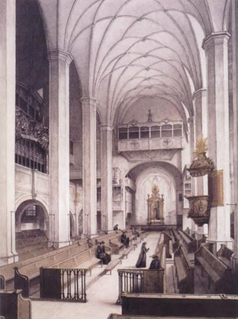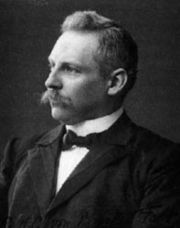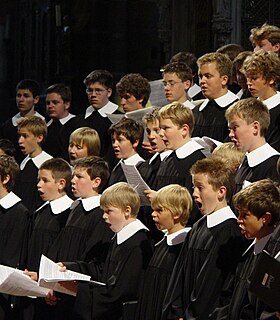
Leiden is a city and municipality in the province of South Holland, Netherlands. The municipality of Leiden had a population of 123,856 in August 2017, but the city forms one densely connected agglomeration with its suburbs Oegstgeest, Leiderdorp, Voorschoten and Zoeterwoude with 206,647 inhabitants. The Netherlands Central Bureau of Statistics (CBS) further includes Katwijk in the agglomeration which makes the total population of the Leiden urban agglomeration 270,879, and in the larger Leiden urban area also Teylingen, Noordwijk, and Noordwijkerhout are included with in total 348,868 inhabitants. Leiden is located on the Oude Rijn, at a distance of some 20 kilometres from The Hague to its south and some 40 km (25 mi) from Amsterdam to its north. The recreational area of the Kaag Lakes (Kagerplassen) lies just to the northeast of Leiden.

Antonius Gerhardus Michael (Ton) Koopman is a Dutch conductor, organist and harpsichordist. He is also professor at the Royal Conservatory of The Hague. In April 2003 he was knighted in the Netherlands, receiving the Order of the Netherlands Lion.
James Whitbourn is a British composer and conductor.

The University of Pretoria – Tuks Camerata is one of five choirs that the University of Pretoria, South Africa has on its campus. The other four are The UP OVUWA, The University of Pretoria Youth Choir, The University of Pretoria Jacaranda Children's Choir and the University of Pretoria Concert Choir. It is the official Choir of the University of Pretoria

The Universel Murad Hassil is one of several international Universal Sufi Universels located in Katwijk aan Zee in the Netherlands. It is also labelled a temple. Earlier, it was envisioned as a Sufi shrine or dargah. On numerous occasions it has been used as a public exhibition space and stage. It is considered part of the cultural history of the municipality.

Max van Egmond is a Dutch bass and baritone singer. He has focused on oratorio and Lied and is known for singing works of Johann Sebastian Bach. He was one of the pioneers of historically informed performance of Baroque and Renaissance music.

Johann Sebastian Bach composed the church cantata Was frag ich nach der WeltBWV 94 in Leipzig for the ninth Sunday after Trinity and first performed it on 6 August 1724. It is a chorale cantata, based on the hymn by Balthasar Kindermann (1664) on a melody by Ahasverus Fritsch.

The Reger-Chor is a German-Belgian choir. It was founded in Wiesbaden in 1985 and has been conducted by Gabriel Dessauer in Wiesbaden. Since 2001 it has grown to Regerchor-International in a collaboration with the organist Ignace Michiels of the St. Salvator's Cathedral of Bruges. The choir performs an annual concert both in Germany and Belgium of mostly sacred choral music for choir and organ. Concerts have taken place regularly in St. Bonifatius, Wiesbaden, and in the cathedral of Bruges in its series "Kathedraalconcerten". The choir performed additional concerts at other churches of the two countries and in the Concertgebouw of Bruges.

Christen, ätzet diesen Tag, BWV 63, is a church cantata by Johann Sebastian Bach. He composed the Christmas cantata for the First Day of Christmas, possibly in 1713 for the Liebfrauenkirche in Halle. He performed it again for his first Christmas as Thomaskantor in Leipzig, on 25 December 1723.

Gerardus Hubertus Galenus von Brucken Fock was a nineteenth-century classical Dutch pianist who gave up his career as a performer to compose and paint.
A Christmas cantata or Nativity cantata is a cantata, music for voice or voices in several movements, for Christmas. The importance of the feast inspired many composers to write cantatas for the occasion, some designed to be performed in church services, others for concert or secular celebration. The Christmas story, telling of music of the angels and suggesting music of the shepherds and cradle song, invited musical treatment. The term is called Weihnachtskantate in German, Cantate de Noël in French. Christmas cantatas have been written on texts in several other languages, such as Czech, Italian, Romanian, and Spanish.

Hans-Christoph Rademann is a German choral conductor, currently the director of the Dresdner Kammerchor and the Internationale Bachakademie Stuttgart.
In allen meinen Taten, BWV 97, is a church cantata by Johann Sebastian Bach. He composed the chorale cantata in Leipzig in 1734 for an unspecified occasion. The text consists of the unchanged words of the hymn by Paul Fleming (1642).

Hans Karl-Friedrich Beringer is a German choral and orchestral conductor, who was from 1978 to 2011 the conductor of the Windsbacher Knabenchor.

The Holy Spirit Orphanage was an orphanage in the city of Leiden in the Netherlands. It is a Rijksmonument located on Hooglandse Kerkgracht 17B.

Herman Strategier (1912–1988) was a composer, organist, and conductor from The Netherlands. Strategier studied at the Roman Catholic School of Church Music in Utrecht. He served as conductor of Leiden's Dutch Madrigal Choir and also composed a number of larger concert works, among them are Don Ramiro (1943) for chorus and orchestra, Rembrandt Cantata (1956), and Shadow out of Time (1973) for ad libitum chorus, flute, percussion, organ, harp, and tape.
Johann Andreas Kauchlitz Colizzi was a Dutch musician, composer and etcher. He was also known as Johannes Colizzi.
Arthur Meulemans was a Flemish composer, conductor, and music teacher.
Greta De Reyghere is a Belgian soprano who specializes in early music and Baroque music in historically informed performance but also performs a variety of other classical music in concert. She is a teacher at the Royal Conservatory of Liège.

The Youth Choir BALSIS is an award-winning mixed youth choir in Riga, Latvia. The choir consists of some 50 young persons from Riga and other cities of Latvia who are permanent singers with the choir. The choir performs about 70 concerts every year in Latvian concert halls, churches and open-air venues.
















